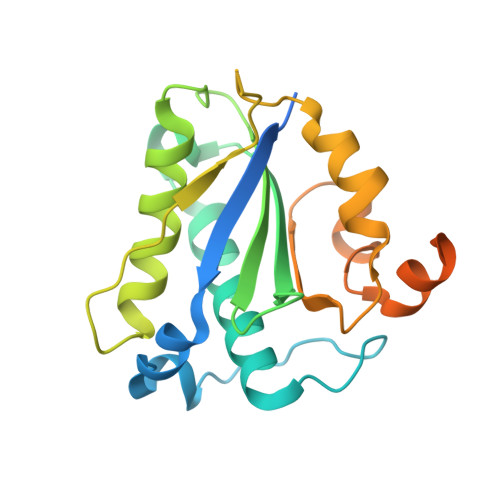High-Resolution Structure of the Nuclease Domain of the Human Parvovirus B19 Main Replication Protein NS1.
Sanchez, J.L., Ghadirian, N., Horton, N.C.(2022) J Virol 96: e0216421-e0216421
- PubMed: 35435730
- DOI: https://doi.org/10.1128/jvi.02164-21
- Primary Citation of Related Structures:
7SZX, 7SZY - PubMed Abstract:
Two new structures of the N-terminal domain of the main replication protein, NS1, of human parvovirus B19 (B19V) are presented here. This domain (NS1-nuc) plays an important role in the "rolling hairpin" replication of the single-stranded B19V DNA genome, recognizing origin of replication sequences in double-stranded DNA, and cleaving (i.e., nicking) single-stranded DNA at a nearby site known as the terminal resolution site (trs). The three-dimensional structure of NS1-nuc is well conserved between the two forms, as well as with a previously solved structure of a sequence variant of the same domain; however, it is shown here at a significantly higher resolution (2.4 Å). Using structures of NS1-nuc homologues bound to single- and double-stranded DNA, models for DNA recognition and nicking by B19V NS1-nuc are presented that predict residues important for DNA cleavage and for sequence-specific recognition at the viral origin of replication. IMPORTANCE The high-resolution structure of the DNA binding and cleavage domain of the main replicative protein, NS1, from the human-pathogenic virus human parvovirus B19 is presented here. Included also are predictions of how the protein recognizes important sequences in the viral DNA which are required for viral replication. These predictions can be used to further investigate the function of this protein, as well as to predict the effects on viral viability due to mutations in the viral protein and viral DNA sequences. Finally, the high-resolution structure facilitates structure-guided drug design efforts to develop antiviral compounds against this important human pathogen.
Organizational Affiliation:
BMCB Graduate Program, University of Arizonagrid.134563.6, Tucson, Arizona, USA.















